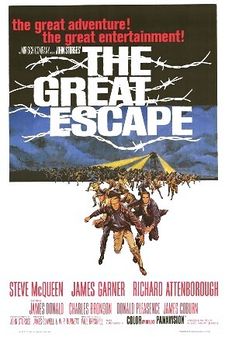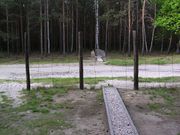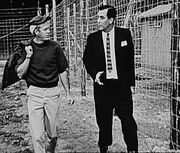The Great Escape (film)
| The Great Escape | |
|---|---|
 original movie poster by Frank McCarthy |
|
| Directed by | John Sturges |
| Produced by | John Sturges |
| Written by | Novel: Paul Brickhill Screenplay: James Clavell W.R. Burnett Walter Newman (uncredited) |
| Screenplay by | James Clavell |
| Starring | Steve McQueen James Garner Richard Attenborough |
| Music by | Elmer Bernstein |
| Cinematography | Daniel L. Fapp |
| Editing by | Ferris Webster |
| Studio | The Mirisch Company |
| Distributed by | United Artists |
| Release date(s) | July 4, 1963 |
| Running time | 172 minutes |
| Country | United States |
| Language | English |
| Budget | $4,000,000 |
| Gross revenue | $5,500,000 (US) |
The Great Escape is a 1963 American film about an escape by Allied prisoners of war from a German POW camp during World War II. It is based on the book of the same name by Paul Brickhill, a novel of the true story of a mass escape from Stalag Luft III in Sagan, which was then part of Germany. The characters in the film are composites of real men. The film was made by the Mirisch Company, released by United Artists, produced and directed by John Sturges, and stars Steve McQueen, James Garner, and Richard Attenborough.
Contents |
Plot
Having wasted enormous resources on recapturing Allied prisoners of war (POWs), the Germans move the most determined to a new, high-security prisoner of war camp. The commandant, Luftwaffe Colonel von Luger, tells the senior British officer, Group Capt Ramsey, "There will be no escapes from this camp." Ramsey replies that it is their duty to try to escape. After several failed escape attempts on the first day, the POWs settle into the prison camp.
Gestapo and SS agents bring Squadron Leader Roger Bartlett (RAF) to the camp and deliver him to von Luger. Known as "Big X," Bartlett is the principal organizer of escapes and Gestapo agent Kuhn suggests that he be kept under the permanent security confinement, which von Luger, contemptuous of the Nazis, will only make a "note" of. As Kuhn leaves, he warns Bartlett that if he escapes again, he will be shot. Bartlett is put with the rest of the POWs.
Locked up with "every escape artist in Germany", Bartlett immediately plans the greatest escape attempted—tunnels for breaking out 250 prisoners. The intent is to "confuse and harass the enemy" to the point that as many troops and resources as possible will be wasted on finding POWs instead of being used on the front line.
Teams are organized to tunnel, make civilian clothing, forge documents, procure contraband materials, and prevent guards from discovering their work. Flight Lieutenant Hendley, an American in the RAF, is "the scrounger" who finds what the others need, from a camera to clothes and identity cards. Australian Flying Officer Louis Sedgwick, "the manufacturer," makes tools such as picks for digging and bellows for pumping air into the tunnels. Flight Lieutenant Danny Velinski and William "Willie" Dickes are "the tunnel kings" in charge of making the tunnels. Eric Ashley-Pitt of the Royal Navy devises a method of hiding bags in the prisoners' trousers and spread dirt from the tunnels over the camp, under the guards' noses. Forgery is handled by Flight Lieutenant Colin Blythe, who becomes nearly blind from intricate work by candlelight. Hendley takes it upon himself to be Blythe's guide in the escape.
The prisoners work on three tunnels simultaneously, "Tom," "Dick" and "Harry." Work on Harry and Dick is stopped so that more work can be performed on Tom. The work noise is covered by the prisoner choir led by Flt Lt Cavendish.
USAAF Captain Virgil Hilts, "The Cooler King," irritates guards with frequent escape attempts and irreverent behavior. His first attempt, conceived in the cooler, is a short tunnel with RAF Flying Officer Archibald Ives; they are caught and returned to the cooler.
While the British POWs enjoy a 4 July celebration organized by the three Americans, the guards discover tunnel Tom. The mood drops to disappointment and hits Ives hardest. He is drawn to the barbed wire that surrounds the camp and climbs it in view of guards. Hilts runs to stop him but is too late, and Ives is machine-gunned dead near the top of the fence. The prisoners switch their efforts to Harry.
Hilts agrees to change his plan and reconnoiter outside the camp and allow himself to be recaptured. The information he brings back is used to create maps showing the nearest town and railway station.

The last part of the tunnel is completed on the night of the escape, but is 20 feet short of woods which are to provide cover. Danny nearly snaps from claustrophobia and delays those behind him, but is helped by Willie. Seventy-six escape.
After attempts to reach neutral Switzerland, Sweden, and Spain, almost all the POWs are recaptured or killed. Hendley and Blythe steal an airplane to fly over the Swiss border, but the engine fails and they crash-land. Soldiers arrive. Blythe, his eyesight damaged, stands and is shot. Hendley waves and shouts "don't shoot", and is captured as Blythe dies. Cavendish, having hitched a ride in a truck, is captured at a checkpoint, discovering another POW, Haynes, captured in his German soldier disguise.
Bartlett is recognized in a crowded railroad station by Gestapo agent Kuhn. Another escapee, Ashley-Pitt, sacrifices himself when he kills Kuhn with Kuhn's own gun, and soldiers then shoot and kill him. In the commotion, Bartlett and MacDonald slip away but they are caught while boarding a bus after MacDonald blunders by replying in English to a suspicious Gestapo agent who wishes them "Good luck". Hilts steals a motorcycle, is pursued by German soldiers, jumps a barbed wire fence but becomes entangled in another and is captured, he escapes execution as a spy by showing them the airforce label on his shirt.
Three truckloads of captured POWs go down a country road and split off in three directions. One truck, containing Bartlett, MacDonald, Cavendish, Haynes and others, stops in a field and the POWs are told to get out and "stretch their legs." They are shot dead. Fifty escapees are murdered. Hendley and nine others are returned to the camp. Von Luger is relieved of command of the prison camp and is driven away by the SS for failing to prevent the breakout.
Only three make it to safety. Danny and Willie steal a rowboat and proceed downriver to the Baltic coast, where they board a Swedish merchant ship. Sedgwick steals a bicycle, then rides hidden in a freight train boxcar to France, where he is guided by the Resistance to Spain. Hilts is brought back alone to the camp and taken to the cooler. Lieutenant Goff, one of the Americans, gets Hilts's baseball and glove and throws it to him when Hilts and his guards pass by. The guard locks him in his cell and walks away, but momentarily pauses when he hears the familiar sound of Hilts bouncing his baseball against a cell wall. The film ends with this scene, under the caption, "This picture is dedicated to the fifty."
Cast
| Actor | Role | Fate |
|---|---|---|
| Steve McQueen | Captain Virgil Hilts USAAF, "The Cooler King" | Recaptured |
| James Garner | Flight Lieutenant Bob Hendley DFC RAF, "The Scrounger" | Recaptured |
| Richard Attenborough | Squadron Leader Roger Bartlett DFC RAF, "Big X" | Recaptured and Executed |
| James Donald | Group Captain Ramsey DSO MC RAF, "The SBO [Senior British Officer]" | Remained in Camp |
| Charles Bronson | Flight Lieutenant Danny Velinski DFC RAF, "The Tunnel King" | Escaped |
| Donald Pleasence | Flight Lieutenant Colin Blythe RAF, "The Forger" | Shot on Sight |
| James Coburn | Flying Officer Louis Sedgwick RAAF, "The Manufacturer" | Escaped |
| Hannes Messemer | Oberst von Luger, "The Kommandant" | N/A |
| David McCallum | Lieutenant-Commander Eric Ashley-Pitt RN, "Dispersal" | Shot on Sight |
| Gordon Jackson | Flight Lieutenant Sandy 'Mac' MacDonald RAF, "Intelligence" | Recaptured and Executed |
| John Leyton | Flight Lieutenant William 'Willie' Dickes RAF, "The Tunnel King" | Escaped |
| Angus Lennie | Flying Officer Archibald 'Archie' Ives RAF, "The Mole" | Shot on Sight |
| Nigel Stock | Flight Lieutenant Denys Cavendish RAF, "The Surveyor" | Recaptured and Executed |
| Robert Graf | Werner, "The Ferret" | N/A |
| Jud Taylor | First Lieutenant Goff USAAF | Failed to escape |
| Hans Reisser | Kuhn, Gestapo | N/A |
| Harry Riebauer | Oberfeldwebel Strachwitz, "The Security Sergeant" | N/A |
| William Russell | Flight Lieutenant Sorren RAF, "Security" | Failed to escape |
| Robert Freytag | Hauptmann Posen, "The Adjutant" | N/A |
| Ulrich Beiger | Preissen, Gestapo | N/A |
| George Mikell | SS-Obersturmführer Dietrich | N/A |
| Lawrence Montaigne | Flying Officer Haynes RCAF, "Diversions" | Recaptured and Executed |
| Robert Desmond | Flying Officer 'Griff' Griffith RAF, "The Tailor" | Recaptured |
| Til Kiwe | Frick, "The Ferret" | N/A |
| Heinz Weiss | Kramer, "The Ferret" | N/A |
| Tom Adams | Flight Lieutenant 'Dai' Nimmo RAF, "Diversions" | Escaped |
| Karl-Otto Alberty | SS-Obersturmführer Steinach | N/A |
Production
Adaptation
The story was adapted by James Clavell, W.R. Burnett, and Walter Newman from Paul Brickhill's book The Great Escape. Brickhill had been a prisoner at Stalag Luft III during World War II.
The screenwriters increased the importance of the roles of American POWs; their role was minor and the escape was a largely British affair.[1] While Americans in the POW camp helped build the tunnels and worked on the early escape plans, they were separated from the Europeans before the tunnels could be completed. Fictional elements were added, such as Hilts's dash for the border by motorcycle. This was done at the request of McQueen, who did the stunt riding himself except for the final jump.
Ex-POWs asked filmmakers to exclude details about the help the POWs received from their home countries, such as maps, papers, and tools hidden in gift packages, lest it jeopardize future POW escapes. The filmmakers complied.[2]
Casting

Steve McQueen's Virgil Hilts, "remains one of the film's most enduring characters, his cooler king having become an icon of cool who continues to inform popular culture." Critic Leonard Maltin wrote that "the large, international cast is superb, but the standout is McQueen; it's easy to see why this cemented his status as a superstar."[3]
Richard Attenborough was cast as Sq Ldr Roger Bartlett RAF ("Big X"), a character based on Roger Bushell, the South Africa-born British POW who was the mastermind of the real Great Escape.[4] Flt Lt Colin Blythe RAF ("The Forger") was based on Tim Walenn and played by Donald Pleasence.[5] Pleasence himself had served in the Royal Air Force during World War II. He was shot down and spent a year in German prisoner-of-war camp Stalag Luft 1.
James Garner had been a soldier in the Korean War and was twice wounded. He was a scrounger during that time, as is his character Flt Lt Hendley.[6]
Hannes Messemer was cast as the Kommandant of Stalag Luft III, "Colonel von Luger," a character based on Oberst Friedrich Wilhelm von Lindeiner-Wildau.[7]
Angus Lennie's Flying Officer Archibald Ives, "The Mole", was based on Jimmy Kiddel, who was shot dead while trying to scale the fence.[8]
Location and set design
The film depicts Tom's entrance as being under a stove and Harry's as in a drain sump in a washroom. In reality, Dick's entrance was the drain sump, Harry's was under the stove, and Tom's was in a darkened corner next to a stove chimney.[9] The motorcycle scenes jumping the barbed wire were shot on meadows outside Füssen in Bavaria, and the "barbed wire" that Hilts crashed into before being recaptured was actually strips of rubber tied around normal wire, constructed by the cast and crew.[10]
Reception
The Great Escape did not command much respect until years after its release. Its audience has broadened, prompting film historians to reappraise its qualities.[11]
In 1963 New York Times critic Bosley Crowther wrote: "But for much longer than is artful or essential, The Great Escape grinds out its tormenting story without a peek beneath the surface of any man, without a real sense of human involvement. It's a strictly mechanical adventure with make-believe men."[12] British film critic Leslie Halliwell described it as "pretty good but overlong POW adventure with a tragic ending".[13] In Time magazine 1963: "The use of color photography is unnecessary and jarring, but little else is wrong with this film. With accurate casting, a swift screenplay, and authentic German settings, Producer-Director John Sturges has created classic cinema of action. There is no sermonizing, no soul probing, no sex. The Great Escape is simply great escapism".[14]
The film has been regularly shown on British TV, especially during periods such as Christmas.[15] In a 2006 poll in the UK, regarding the family movie that TV viewers would most want to see on Christmas Day, The Great Escape came in third, and was first among the choices of male viewers.[16]
In 2009 seven POWs returned to Stalag Luft III for the 65th anniversary of the escape[17] and watched the film. According to the veterans, the first half depicting life in the camp is authentic; for example, the machine-gunning of a man who snaps and tries to scale the fence, and the way the tunnels were dug. However, one veteran criticized McQueen for glamorizing the situation.[18]
In popular culture
References to scenes and motifs from the film, as well as Elmer Bernstein's theme, have appeared in other films, television series, video games, advertisements, and as a mobile phone ringtone. These include Monty Python's Flying Circus, Supernatural, The Simpsons, Hogan's Heroes, Nash Bridges, Seinfeld, Get Smart, Red Dwarf,Recess and the films Chicken Run, Reservoir Dogs, The Parent Trap, Top Secret! and Charlie's Angels.[19]. The theme tune has also been adopted by England football fans. Recently Shaun the Sheep parodied the great escape in the episode Fleeced.
TV sequel and video games
A fictionalized, made-for-television sequel, The Great Escape II: The Untold Story, appeared years later. It starred Christopher Reeve with Donald Pleasence as an SS villain.[20]
Several video games were based on the movie, including the 1986 Ocean Software game available for various home computer platforms[21], and the 2003 SCi Games (Eidos) release for PlayStation 2, XBox, and Windows[22].
See also
- Stalag Luft III, and its section The "Great Escape", which covers the real escape.
References
- ↑ Wolter, Tim (2001). POW baseball in World War II. McFarland. pp. 24–5. ISBN 978-0786411863. http://books.google.com/books?id=Arvnfb9UtSMC&pg=PA24.
- ↑ The Great Escape: Heroes Underground documentary, available on The Great Escape DVD Special Edition.
- ↑ Maltin, Leonard (1999). Leonard Maltin's Family Film Guide. New York: Signet. p. 225. ISBN 0-451-19714-3.
- ↑ Whalley, Kirsty (2008-11-10). "Escape artist’s inspiring exploits". This is Local London (Newsquest Media Group / A Gannett Company). http://www.thisislocallondon.co.uk/indepth/nostalgia/3831930.Escape_artist/. Retrieved 2009-09-25.
- ↑ "Now sporting a huge, bushy moustache ... he set to work arranging the operations of the forgery department" (Vance 2003, p. 44)
- ↑ DVD extra
- ↑ Carroll, Tim (2004). The Great Escapers. Mainstream Publishing. ISBN 1-84018-904-5.
- ↑ Hall, Allan (2009-03-24). "British veterans mark Great Escape anniversary". Telegraph.co.uk (Telegraph Media Group Limited). http://www.telegraph.co.uk/news/worldnews/europe/germany/5043863/British-veterans-mark-Great-Escape-anniversary.html. Retrieved 2009-10-26. Archived version 2009-10-26
- ↑ (Vance 2003, p. 116-118)
- ↑ Rufford, Nick (2009-02-13). "Video: The Great Escape, re-enacted". Times Online (Times Newspapers Ltd). http://www.timesonline.co.uk/tol/driving/videos/article5718912.ece. Retrieved 2009-10-20. See 4th paragraph. Archived version 2009-10-20
- ↑ Eder, Bruce (2009). "allmovie - Review: The Great Escape". AllMovie. Macrovision Corporation. http://www.allmovie.com/work/the-great-escape-20652/review. Retrieved 2009-10-14.
- ↑ Bosley Crowther (1963-08-08). "P.O.W.'s in 'Great Escape':Inmates of Nazi Camp Are Stereotypical – Steve McQueen Leads Snarling Tunnelers". The New York Times. http://movies.nytimes.com/movie/review?_r=1&res=9A06E7DE1431E73BBC4053DFBE668388679EDE. Retrieved 2008-11-03.
- ↑ Walker, John (1997). Halliwell's film and Video Guide. London: HarperCollins. p. 311. ISBN 006387799.
- ↑ "Cinema: The Getaway". Time. Time Inc.. 1963-07-19. http://www.time.com/time/magazine/article/0,9171,896917,00.html. Retrieved 2009-10-12.
- ↑ Empire - Special Collectors' Edition - The Greatest Action Movies Ever, published in 2001
- ↑ "TV classics are recipe for Christmas Day delight". [[Freeview (UK)|]]. 2006-12-11. http://www.freeview.co.uk/freeview/Press/2006/TV-classics-are-recipe-for-Christmas-Day-delight. Retrieved 2009-09-05. Archived version 2009-09-05
- ↑ "Veterans of the Great Escape visit old stalag" article at The Independent website
- ↑ "'Great Escape' PoWs remember comrades... and boo 'silly' Steve McQueen", The Times
- ↑ Nixon, Rob (2008). "Pop Culture 101: The Great Escape". Turner Classic Movies, A Time Warner Company. http://www.tcm.com/thismonth/article/?cid=190976&rss=mrqe.
- ↑ http://www.imdb.com/title/tt0095252/
- ↑ http://www.mobygames.com/game/great-escape
- ↑ http://www.mobygames.com/game/great-escape-
Bibliography
- The Great Escape, Paul Brickhill.
- The Tunnel King, The True Story of Wally Floody & the Great Escape, Barbara Hehner. Publ.: Harper Trophy Canada 2004.
- The Longest Tunnel, Alan Burgess.
- "Tre kom tilbake" (Three returned)", the Norwegian book by surviving escapee Jens Müller. Publ.: Gyldendal 1946.
- Exemplary Justice, Allen Andrews. Details the manhunt by the Royal Air Force's special investigations unit after the war to find and bring to trial the perpetrators of the "Sagan murders".
- 'Wings' Day, Sydney Smith, story of Wing Commander Harry "Wings" Day Pan Books 1968 ISBN 0330024949
External links
- The Great Escape at the Internet Movie Database
- The Great Escape at the TCM Movie Database
- The Great Escape at Allmovie
- The 1963 Film of "The Great Escape" at History in Film
- James Garner Interview on the Charlie Rose Show (See 30:23–34:47 of video.)
- Photos of the filming (See last photos of webpage.)
- [1]
|
||||||||||||||